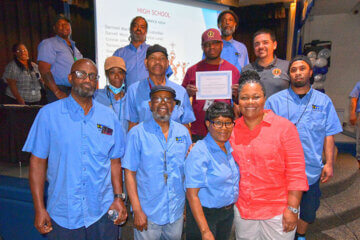To put it simply, a deficiency on a janitorial inspection is when a line item falls below an acceptable level. The question is, how can you determine what that level should be?
Your business or organization’s definition of a “deficiency” level will depend on a variety of factors, including:
- Industry standards, such as APPA’s five custodial service levels within the educational facilities industry
- Your client’s expectations, which may be outlined in your contract or service-level agreement (SLA)
- The standards of the facility you are contracted to manage
If you don’t already have a system in place or an industry standard, our article on choosing the right rating system for your forms can help narrow down the choices (such as pass/fail, 1–3, or 1–5). You might also find our guide to setting quality control goals for your team helpful if you’re beginning this process from scratch.
If you use a mobile inspection app, such as OrangeQC, you’ll be able to customize what gets flagged as “deficient.” Let’s take a deeper look at what to consider when setting that level.
What makes a line item deficient?
The level at which you consider a line item deficient is entirely up to you! For instance, within OrangeQC, you can set it so that if a line item is rated a 2 out of 5, then it will be highlighted in red and flagged as deficient by the software.
But, as we discussed, deficiency definitions vary. You are in charge of setting the standards for your team.
How should you determine deficiency standards?
APPA service levels and ISSA CIMS certification both offer insights into acceptable levels of clean. After you have reviewed these standards and applied them to your OrangeQC inspection forms, now you will need to determine how they should be customized. Consider your service level agreement or your contract with your client when customizing deficiency standards. If you or your team is not providing the service specified in your agreement with your client, then it should be considered deficient.
What do you want flagged?
In the OrangeQC software, when a line item is rated as deficient, it is highlighted in red and marked as flagged. This is why it is important to set a standard deficiency rating because you do not want minor issues flagged in this way — if everything is deficient, it becomes a meaningless distinction. The violation should be serious enough to warrant being brought to your attention.
A good example of a line item deficiency is: your team left a trash can overflowing in a room that they just serviced. This is a major problem because your client specified trash removal as a part of your contract. You will want this violation flagged and highlighted in your OrangeQC inspection form so you can address the issue with your team and correct the error.
How deficiencies relate to corrective actions
Usually deficiencies trigger corrective actions. In the example above, if a trash can is left full, then someone will need to go back and empty it. You should consider the difference between what you want your team to fix now, versus what you want them to clean better next time.
Why set deficiency standards?
Setting deficiency standards allows you to see quality levels at a glance. This is why it is important to define deficiencies and not just simply use a rating number. It is helpful to know that your team is averaging an 88% on inspections, but you also want to know about specific line items that are marked deficient. Seeing the deficient line items will allow you to stay on top of things and correct mistakes before they become customer complaints.
If the administrative team at your facility wants to hear about quality control on an APPA scale and you want to see percentages, then we have a free APPA level-to-percentages conversion tool that will allow you to convert between the two.
Communicating deficiencies to your team
Managers, inspectors, team leaders, and staff all need to be on the same page when it comes to determining whether something is deficient. Repeated deficiencies could be a sign that your janitorial team needs more training so that they can better meet the expectations of the client. Repeat deficiencies can also mean that your team needs different resources. THat might mean cleaning tools, additional staff, or more time to improve the quality of their service.
The presence of a deficiency can tell you that something’s off, but not necessarily what that something is; for that, you’ll need to speak with your inspectors and cleaning staff.
Being able to control deficiency settings and definitions with OrangeQC software is valuable in two ways. First of all, it allows managers and administrators to see evidence that teams are adhering to the quality control standards. Secondly, it makes evident any repeated deficiencies that need to be addressed with your team.
The inspection software is also a great tool for opening a line of communication with your team. This will make it easier to address any deficiencies that need to be fixed now or in the future.
Are ready to take your janitorial team to the next level with a simpler, easier, and more powerful janitorial inspection tool? Start a free 30-day trial of OrangeQC.



